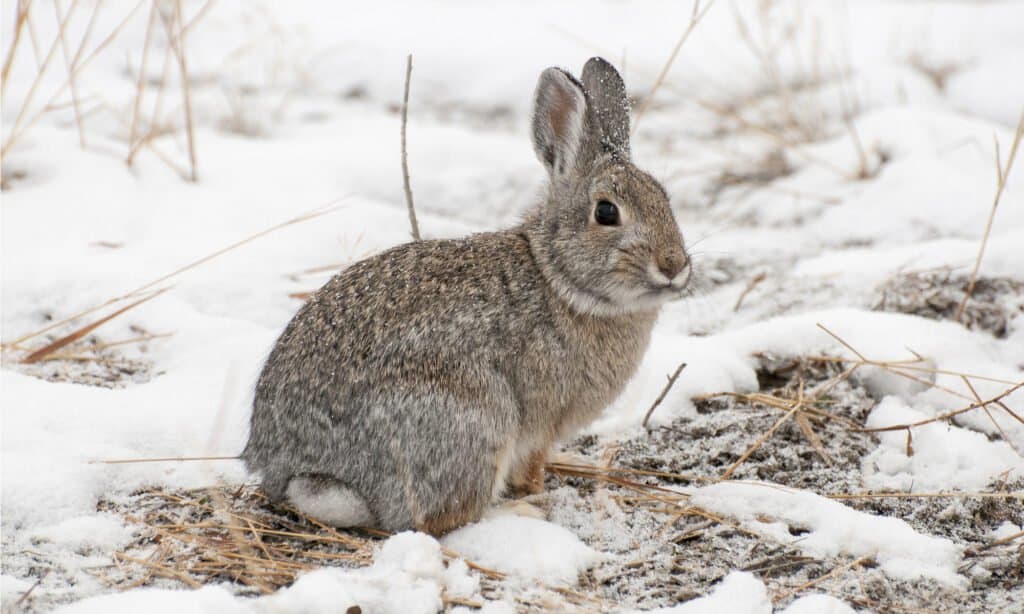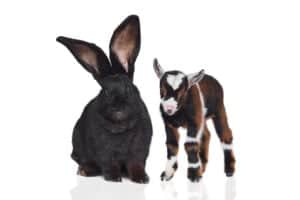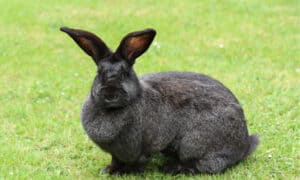Rabbits are cute, docile mammals found on every continent except Antarctica. There are 29 species of wild rabbits and over 305 recognized breeds of domestic rabbits. Rabbits in the wild are around 15-16 inches long and weigh about 2.5 pounds, depending on their species. Because rabbits breed profusely, it is hard to estimate their global population. Some experts believe there are more than 300 million rabbits in the world. Wild rabbits often live in areas that get pretty cold. They are frequently found in northern North America, Canada, and other northern countries like Finland.
Rabbits are in the same family as hares, but the two species are quite different. Hares are larger, have longer ears, and have longer legs. They also have some lifestyle differences. Many hare species live alone or with one other hare above ground, while rabbits usually live in larger groups in underground burrows or nests.
Where Do Rabbits Go in the Winter?

During winter, rabbits go into their underground burrows.
©moosehenderson/Shutterstock.com
Rabbits are actually pretty hearty when it comes to cold temperatures despite their small size. They stop shedding their fur when temperatures drop, which allows them to develop a thick winter coat to keep them warm. As warm-blooded creatures with an internal body temperature of between 101 and 103 degrees, they can maintain their body temperature outside in temperatures as low as 32 degrees Fahrenheit (freezing).
When temperatures go below freezing, rabbits head underground to their burrows. They snuggle together and have already lined their burrows with straw and grass to make them even cozier. These shelters also help them to hide from predators.
Bunnies change up their food sources in the winter, both due to lack of availability and so they don’t have to travel as far to find a snack or meal. They can shift to eating a coarser diet of things like twigs or wood chips. They also tend to seek out short bushes or other plants that do not get buried in the snow. They also eat their own excrement, which gives them plenty of B vitamins and extra nutrition when other food sources are not available.
Another way rabbits stay warm in the winter is by reducing their activity. They don’t hibernate, but they do stay inside more to conserve calories. They use stores of fat in their body to maintain their internal body temperature.
Wintertime Rabbits Nuisances

Rabbits can damage plants in the yard.
©Rob Hyrons/Shutterstock.com
Some people find that rabbits can become a nuisance in the wintertime, especially if they have plants that rabbits enjoy eating, like hostas, in their yards. Not only can rabbits damage the plants beyond repair by munching on the stems, but they can also leave a large number of rabbit pellets in the yard.
You can keep rabbits away from your plants in some surprising ways. Experts do not recommend fencing your whole yard to keep out rabbits because they can easily squeeze under them and may like the safety that a fenced yard can offer from predators. They recommend putting fencing around the plants that rabbits love instead. If you do use fencing, you should make sure the fence goes at least 6 inches underground to prevent rabbits from burrowing underground to get to the foods they love.
You should also clear your yard of twigs regularly in winter since rabbits like to gnaw on them as part of their cold-weather diet. Rabbit repellents like flashing lights or noisemakers aren’t really effective and can be more annoying to humans and animals alike. However, allowing your dog to hang out in the yard should be a strong deterrent to any curious rabbits nearby.
Some people resort to trapping rabbits in their yards to curb the rabbit problem. However, experts discourage this because this can lead to the spread of diseases that rabbits may carry.
Up Next:
- Rabbit Lifespan: How Long Do Rabbits Live?
- Wild vs domestic rabbits: Differences explained
- Do Rabbits Hibernate?
- What Do Cottontail Rabbits Eat?
The photo featured at the top of this post is © LNbjors/Shutterstock.com
FAQs (Frequently Asked Questions)
Where do rabbits go in the winter?
When temperatures go below freezing, rabbits head underground to their burrows. They snuggle together and have already lined their burrows with straw and grass to make them even cozier. These shelters also help them to hide from predators.
What is the difference between a rabbit and a hare?
Rabbits are in the same family as hares, but the two species are quite different. Hares are larger, have longer ears, and have longer legs. They also have some lifestyle differences. Many hare species live alone or with one other hare above ground, while rabbits usually live in larger groups in underground burrows or nests.
What do rabbits eat in the winter?
Bunnies change up their food sources in the winter, both due to lack of availability and so they don’t have to travel as far to find a snack or meal. They can shift to eating a coarser diet of things like twigs or wood chips. They also tend to seek out short bushes or other plants that do not get buried in the snow. They also eat their own excrement which gives them plenty of B vitamins and extra nutrition when other food sources are not available.
Do rabbits hibernate?
Another way rabbits stay warm in the winter is by reducing their activity. They don’t hibernate, but they do stay inside more to conserve calories. They use stores of fat in their body to maintain their internal body temperature.
Thank you for reading! Have some feedback for us? Contact the AZ Animals editorial team.






